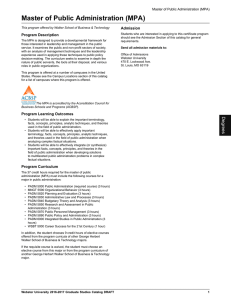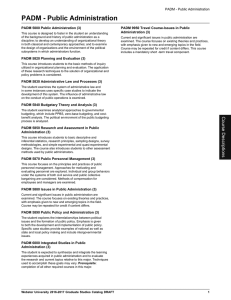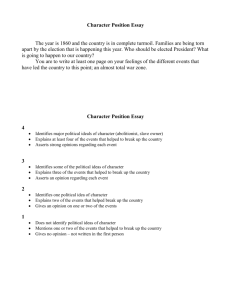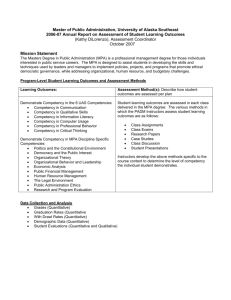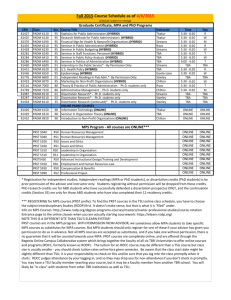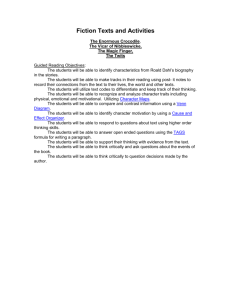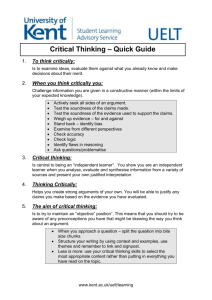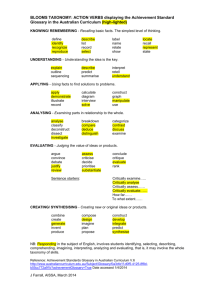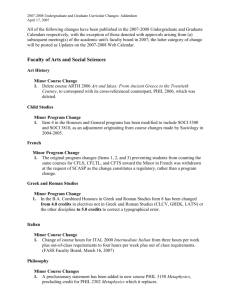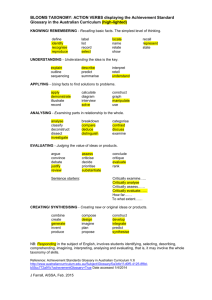UNT MPA ASSESSMENT PLAN, 2012-2019
advertisement
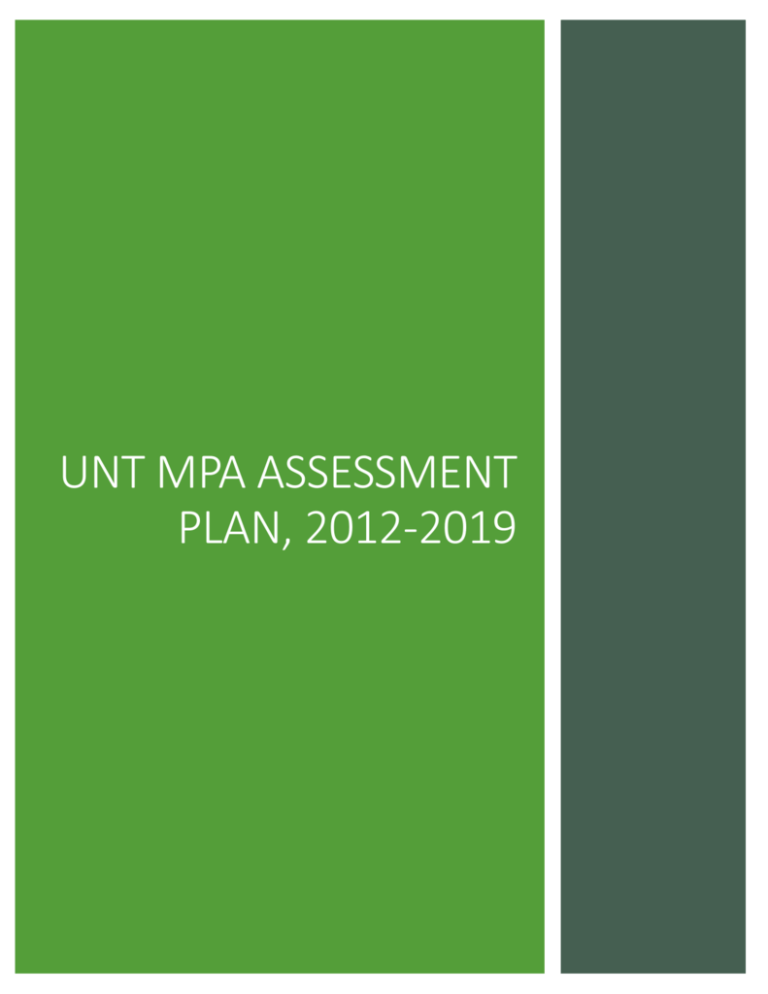
UNT MPA ASSESSMENT PLAN, 2012-2019 1 Mission Driven Assessment The mission of the Master of Public Administration program is: “to prepare leaders for public and nonprofit organizations through an innovative curriculum and dedicated teaching; creating and disseminating knowledge to the field of public administration through interdisciplinary research and professional development activities; and serving the profession and the community in order to promote democratic governance and enhance quality of life.” The first efforts at developing a mission statement and vision began in August 1993 and during a retreat in 1994, the faculty developed mission and vision statements for the MPA program along with a five-year strategic plan. Since that time, the department has sought information from stakeholders to inform strategic planning processes which always include a review of mission. Among the stakeholders involved have been department faculty, staff, students, alumni, internship sponsors and employers. Data collection for stakeholders has included informal processes including discussions at faculty meetings, emails, and conversations. Formal data collection has also been received via alumni surveys, student exit surveys, and internship reviews. The program has an active alumni group (many of whom are now employed and active in hiring decisions and sponsoring paid internship for MPA students). The alumni have been involved in shaping mission through their consistent involvement as guest speakers and they have also provided information that can be used in mission formation or alteration through ---quarterly meetings with the Chair. These core groups of stakeholders have all provided information useful to the program and it has been used by the department in mission related actions. 2 Universal Competencies The UNT MPA program assesses NASPAA universal competencies on a periodic basis such that all competencies should be assessed every five years. The process is centered on a oneyear cycle for some assessment instruments, two-year cycle for rubric-based assessment instruments, and a five-year cycle for other instruments. Instruments are formally reviewed by the department’s CDPC committee. This process enables us to collect multiple data points, assess performance, and make changes to the program on a continuing basis without overburdening staff and faculty with the assessment process. The tables and figures below outline the SLO’s associated with each universal competency and the process is detailed below. Table 1. Student Learning Objectives for Universal Competencies by Core Courses Universal Competency SLO To lead and manage in public governance 1. Explain the general practice of leading and managing high-performance public organizations 2. Impart and develop analytical thinking skills through practice of human resource management. To participate in and contribute to policy process: 1. Recall and explain key justifications for public policy, especially those grounded in economic theory and institutions of a market economy. 2. Critically evaluate the implications of proposed revenue policy changes for equity, economic efficiency, and administrative feasibility To analyze, synthesize, think critically, solve problems and make decisions 1. Critically evaluate the implications of proposed revenue policy changes for equity, economic efficiency, and administrative feasibility 2. Demonstrate how to be an educated and intelligent consumer of statistical analysis results and processes. To articulate and apply a public service perspective 1. Compare and contrast major schools of thought regarding the role of public administration in the United States. 2. To appreciate the multiple perspectives, values, and ethical challenges of public management. To communicate and interact productively with a diverse and changing workforce and citizenry 1. Appreciate the multiple perspectives, values, and ethical challenges of public human resource management. 2. Media relations: preparing for an interview, print versus electronic media, the public information office, media relations in times of crises; Course PADM 5020 PADM 5030 PADM 5010 PADM 5420 PADM 5420 PADM 5510 PADM 5010 PADM 5020 PADM 5030 PADM 5035 Elective Competencies The UNT MPA Program is still developing a strategy for assessing elective competencies derived from sub-fields of study. The development of SLO’s is an ongoing process that has highlighted the difficulty of assessing competencies when fields are not audited for graduation requirements. Resolving these issues continues to be a point of discussion for the program. 3 Assessment Process The assessment process collects data from multiple sources across multiple time periods to inform the review of student learning outcomes. The overall process is graphically summarized in Appendix 1.1, and a matrix of which instruments are used to assess SLOs is specified in tabular form in Appendix 1.2. Key assessment rubrics are included in Appendix 1.3. The next section provides a narrative description of the application of assessment instruments from data collection to analysis to departmental review procedures. Assessment Instruments 1. Comprehensive exam. Students must pass a comprehensive exam as an exit requirement for the program. The exam is offered three times yearly. In February of even-numbered years, ten exams are randomly selected from the six previous exam offerings. A threeperson committee applies a rubric (Appendix 1.3) to assess the following SLOs: 1.1, 2.1, 3.1, 3.2, 4.1, 5.1. A summary report is submitted to the CDPC committee by May 31st of even numbered years. 2. Problem-solving projects. Students complete two significant problem-solving projects in required coursework. The first assignment from PADM 5400 is a budget analysis of a municipality or nonprofit organization. The second is an assignment from PADM 5510 that requires students to employ research design and statistical analysis to answer questions in a problem-solving context. In February of even-numbered years, ten projects from each course are randomly selected from course offerings in the previous four long semesters. A three-person committee applies a rubric (Appendix 1.4 and 1.5) to assess the following SLOs: 3.1, 3.2. A summary report is submitted to the CDPC committee by May 31st of even numbered years. 3. Student self-evaluations. Students evaluate their own growth and development, as well as the performance of the program toward the end of their program in PADM 5035. Students provide three points of assessment in this course. First, students provide a qualitative assessment of the program and their experience through a reflective paper. In February of even-numbered years, ten of these papers from all course offerings over the last two years are randomly selected and submitted to the CDPC by May 31st of evennumbered years. Second, students participate in a faculty-moderated focus group. Results are recorded, and all summaries from the previous two years are submitted to the CDPC by May 31st of even-numbered years. Finally, all students complete a closedended survey whose results are compiled and summarized by staff. Summary tables are submitted to the CDPC by May 31st of even-numbered years. Student self-evaluation provides assessment of all SLOs. 4. Practitioner Evaluations. Practitioners offer evaluations of student performance through internship documentation. The internship coordinator randomly samples 10 evaluations 4 per long semester and records evaluations from relevant questions. By May 31st of even numbered years, the internship coordinator provides a summary report of finding to the CDPC. 5. Alumni Evaluations. The department chair will conduct an alumni survey in the Spring semester of years divisible by five. The instrument will be designed to assess all SLOs from the post-degree experience of alumni. The last available survey is 2007 with the next scheduled alumni survey 2015. Review Process All materials from the assessment process and instruments are submitted to the department’s CDPC committee by May 31st of even-numbered years. The committee is tasked with reviewing the assessment materials and providing a report to the faculty with recommendations for changes to the program’s mission, curriculum, extra-curricular activities, and assessment process. Recommendations are due no later than the October faculty meeting of even-numbered years. 5 Appendices Appendix 1.1 Assessment Process Appendix 1.2 Assessment Instrument Matrix Appendix 1.3 Assessment Committee Rubrics 6 Appendix 1.1 Assessment Process 7 Universal Competency Course Assessment Instruments SLO Comp Exam Budget Project Stats Project Self-Eval Practitioner Eval Alumni Survey To lead and manage in public governance 1. Explain the general practice of leading and managing PADM 5020 X X X X high-performance public organizations 2. Impart and develop analytical thinking skills through PADM 5030 X X X practice of human resource management. To participate in and contribute to policy process: 1. Recall and explain key justifications for public policy, PADM 5010 X especially those grounded in economic theory and institutions of a market economy. 2. Critically evaluate the implications of proposed revenue PADM 5420 X X X policy changes for equity, economic efficiency, and administrative feasibility To analyze, synthesize, think critically, solve problems and make decisions X 1. Critically evaluate the implications of proposed revenue PADM 5420 X X X policy changes for equity, economic efficiency, and administrative feasibility 2. Demonstrate how to be an educated and intelligent PADM 5510 X X X consumer of statistical analysis results and processes. To articulate and apply a public service perspective 1. Compare and contrast major schools of thought PADM 5010 X X X X regarding the role of public administration in the United States. 2. To appreciate the multiple perspectives, values, and PADM 5020 X X X X ethical challenges of public management. To communicate and interact productively with a diverse and changing workforce and citizenry 1. Appreciate the multiple perspectives, values, and ethical PADM 5030 X X X X challenges of public human resource management. 2. Media relations: preparing for an interview, print versus PADM 5035 X electronic media, the public information office, media relations in times of crises; Appendix 1.2 8 Assessment Instrument Matrix Appendix 1.3 Assessment Committee Rubrics 9 Core Competency Unacceptable Proficiency Scoring Range (1‐3) Proficient Scoring Range (4‐7) Explain the general practice of leading and managing high‐ performance public organizations. General practices of leadership and management of high performance public organizations not identified. Fails to explain terms introduced. Correctly identifies two or more general practices of leadership and management of high performance public organizations. Explains them. Recall and explain key justifications for public policy, especially those grounded in economic theory and institutions of a market economy. Identifies only one or none of the justifications for public policy or fails to explain them adequately. Exemplary Proficiency Scoring Range (8‐10) Identifies two or more general practices of leadership and management of high performance public organizations, explains and critically evaluates use of them. Identifies most of the justifications for Identifies and explains all of the public policy and adequately explains them. justifications for public policy and critically evaluates these justifications. Critically evaluate the implications of Mentions but does not critically evaluate Explains the implications of proposed revenue policy changes for: equity, proposed revenue policy changes for equity, economic efficiency, and administrative feasibility. economic efficiency, and administrative equity, economic efficiency, and feasibility. Sine critical analysis offered. administrative feasibility Critically evaluates the implications of proposed revenue policy changes for equity, economic efficiency, and administrative feasibility. Consume statistical analysis results and processes in an educated and intelligent manner. Fails to interpret correctly linear Correctly interprets linear regression regression models or to explain models and adequately explains elements adequately elements of research design. of research design. Compare and contrast major schools of thought regarding the role of public administration in the United States. Appreciate the multiple perspectives, values, and ethical challenges of public human resource management. Identifies and explains two or fewer major schools of thought. Explanations sometimes inaccurate Identifies and explains three major schools Identifies and explains three major of thought. Critically compares two schools schools of thought. Critically compares of thought. Accurate. three schools of thought. Accurate and thorough. Identifies only one or none of the perspectives, values, and ethical challenges of public human resource management. Fails to explain them. Identifies two or three perspectives, values, and ethical challenges of public human resource managementand adequately explains them. Identifies and explains multiple perspectives, values, and ethical challenges in public human resource management. Critically evaluates these. Scoring Range (32‐56) Scoring Range (64‐100) Overall Proficiency Exam Semester Exam ID # Student Name Scoring Range (8‐24) Correctly interprets linear regression models and adequately explains elements of research design. In addition, communicates results correctly using plain language. Score Competency III: To analyze, synthesize, think critically, solve problems and make decisions. Assessment Tool: Methods 5510 Final Project Student ID ___________________________________________________ Indicators Can the student formulate and state a research question? Unacceptable Proficiency Scoring Range (1‐3) Inability to formulate and state a research question clearly and concisely. Co discussion of important components of the research problem. Can the student provide a sufficient literature review that supports their research question? Can the student select the correct method of analysis? Failed to review relevant literature. Literature review does not include relevant information or appropriate sources. Failed to identify the appropriate analysis model given the data measurement. Can students test for the OLS assumptions in their analysis? Do students select appropriate variables for their regression models? Overall Proficiency Proficient Score Range 4‐7 Formulates and states the research questions. Also provides some discussion of research questions and important components of the problem. Provides some review of relevant and appropriate literature to support their argument. Demonstrates some effort in selecting the appropriate model for analysis but does not justify their reasoning for using the model. The student failed to test for The student provides some violation of any OLS assumptions. discussion of the OLS assumptions and provides some effort in addressing any assumption violations. Provides a superficial justification Provides some justification for the selection of independent pertaining to the inclusion of independent and dependent and dependent variables. variables. Also provides some Student is unclear in the discussion of how variables were operationalizing of concepts. operationalized. Scoring range (5‐15) Scoring range (20‐35) Exemplary Proficient Score Range (8‐10) Formulates and states research question with a clear and concise definition of the problem, using outside information sources to support their research question. Thoroughly reviews the literature demonstrated by inclusion of a variety of sources and relevant literature. Demonstrates ability to select he appropriate model based on data collection strategy. They also discuss why the chosen model is appropriate for their analysis. The student fully tests and correctly discusses the OLS assumptions. All appropriate corrections are made. Identifies independent and dependent variables correctly, with rationale as supported by literature and/or theory. Full discussion of how variables were operationalized. Scoring range (40‐50) Competency matrix for the field assignment in PADM 5400, Managing Financial Resources Student ID ______________________________ Indicators Unacceptable proficiency (Scores 1-3) Proficient (Scores 4-7) Describe budget process in detail Interview two budget officials Nonexistent or superficial description No evidence of interviews conducted Description sufficient to understand process Evidence that two officials were interviewed Identify key participants in budget process and their roles Description sufficient to understand who key players are and their roles Identify and evaluate the organization’s budget policies Nonexistent to brief description of key participants and their roles Nonexistent or brief discussion of budget policies Evaluate process for preparing revenue forecasts No discussion of revenue forecast procedures or policies Description of revenue forecasting methods and policies Evaluate the content of budget document and its presentation of information Nonexistent or brief discussion budget document and its information format Description of budget document and the general approach used to budgeting Discussed citizen engagement in budget process No discussion of role of citizens in budget preparation Discussion of efforts to engage citizens in budget preparation Recommendations made for improving both budget process and content One or two recommendations offered with limited discussion (Score range: 8-24) At least three substantive recommendations offered and discussed in some detail (Score range: 25-56) Overall proficiency Discussion sufficient to understand organization’s values and processes Exemplary proficiency (Scores 8-10) Extensive description of process and organizational dynamics Evidence that more than two officials were interviewed with substantial amount of info collected Extensive description of key players and detailed discussion of their roles and conflicts in those roles Discussion demonstrates understanding of the role of policies in the organization’s budget processes Discussion of the methods and policies and problems encountered in revenue forecasting Extensive discussion of budget document, the evolution of innovations in organization, and its context to innovation in public administration More extensive discussion of innovations and obstacles to engaging citizens in budget process At least five substantive recommendations offered and discussed along with obstacles to their implementation (Score range: 57-80) Scores by indicator
